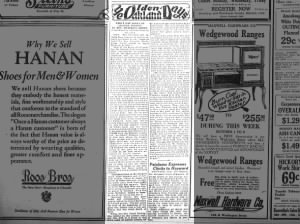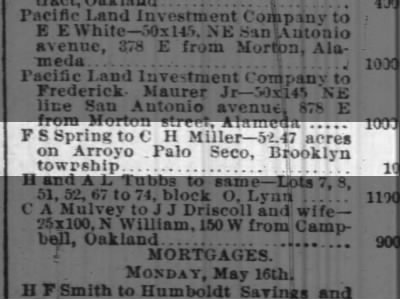EARLY DAY NOTES ON LINCOLN AVENUE. - Ye Olden Oakland Days - Oakland Tribune - 30 Sep 1923, Sun - Page 4
 Sun, Sep 30, 1923 – Page 4 · Oakland Tribune (Oakland, California) · Newspapers.com
Sun, Sep 30, 1923 – Page 4 · Oakland Tribune (Oakland, California) · Newspapers.comYe Olden Oakland Days
EARLY DAY NOTES ON LINCOLN AVENUE.
By REV. FRANKLIN RHODA.
(Contributed by Oakland Pioneers. No. 115.)(Note. The following are extracts from a series of articles recently published in the "Diamond News'' by Rev. Franklin Rhoda, whose family settled in upper Fruitvale in 1860.)
"One of the finest of all qualities, the highest of all attainments, after the capacity to appreciate God, is the appreciation of our neighbors. One of the saddest facts about our fallen humanity is that from age to age, and with every race of man, it holds true, that the prophet is not without honor save in his own home and among his own neighbors. I am glad of this opportunity to do what I may to make the dwellers near Dimond acquainted with their neighbors on Lincoln avenue. It is probably known to few or none of our present settlers hereabouts, that of the past and present residents along this avenue. thirteen or more have a state-wide reputation. or these possibly half may be said to have a national reputation, and several are internationally known."
 |
| My best guess on the Lincoln Avenue to 13th Avenue route that Rhoda describes, based on this 1894 George Sandow map. |
"Roughly speaking, Lincoln avenue is the lineal successor to a road over which the first lumber cut in the state after the gold discovery, was hauled by ox teams to the ferry at the foot of Thirteenth avenue, East Oakland, to be shipped to San Francisco. Probably lumber was cut here by whites as early as 1847. The old ox road was the lineal successor of a very ancient Indian trail that crossed the range close to the south slope of Redwood Peak, and led on across ridges and canyons, on and on into the San Joaquin Valley. As Indian trails are the most permanent and enduring of things, it is a safe guess that this trail antedated even the Mexican occupation. As John C. Fremont camped on this trail, where the Joaquin Miller cottage now stands, nearly eighty years ago, and named the Golden Gate, as at the time of the equinox he gazed on the sun setting between the north and south portal of that gate, he may be counted as the first notable sojourner on Lincoln avenue.
"Let us start lower down on the avenue and take that delightful walk up toward 'The Hights,' as Joaquin Miller loved to call them. Let us drop in and see Edwin Markham (I speak in the present tense, but fame called, so Markham is now a resident of Long Island).
 |
| This "Alameda County No. 2" map, not perfectly aligned, shows the Reichert property to be between moden Lincoln Ave (yellow road seen underneath, not yet built when map was drawn) and Maple Avenue. This is about where the Mormon Temple and Greek Orthodox church are, now. |
"Markham lived on the Reichert place, some distance east of Lincoln avenue. There he began his career as writer and poet; at least, the public away from home began to appreciate him as such. There he wrote 'The Man With the Hoe,' while acting as principal of a public school in Oakland. With this poem Markham 'leaped to fame,' as one of his critics has put it.
"Ambrose Bierce, the great writer and correspondent, frequently visited his friend Markham on Lincoln avenue, One day, about the time of the beginning of the great war, Bierce took a trip into Mexico and was never heard of more.
 |
| The sharp bend in Lincoln was about where the modern intersection of Lincoln Avenue and Lincoln Way is; the road switched back on itself as the grade got steeper below what is now Highway 13. I think Lincoln Way is the old road. |
"There was Mrs. Isabel Darling, who resided on this ancient trail, and who died in a house in their sharp angle of Lincoln avenue, as it makes its last climb to the Miller settlement. She was Joaquin Miller's scribe, said to be the only person who could, in all cases, decipher the great poet's hieroglyphics.
[See below for more research into Isabel Darling and A. W. Darling. - MF]
"Seventeen years after the time of Colonel Fremont, to-wit, in 1863, we see Albert Bierstadt with his easel set up by the trail, and he is trying, as painters do, with the poor materials, of brush and pigment and palette, to transfer to mere canvas the ineffable glories of the sun and bay and sky. Some men are standing by - Artemus Ward, Fitzhugh Ludlow and Joaquin Miller. Fremont, never forgetting his camp on the mountain side, sent Bierstadt to paint the 'golden' gate. Joaquin Miller, never forgetting the day he stood there with Bierstadt, came back 23 years later and bought that place.
[I have not been able to find this painting. There is a painting by Bierstadt made in 1900 titled "The Golden Gate", from a viewpoint on a western shoreline of San Francisco. It's definitely not the painting described above. I would like to find an image of the circa 1863 painting, if it exists. If you know of one, please let me know. It's not in this List of works by Albert Bierstadt. See more about the painting here: PLEA IS MADE TO HONOR FREMONT- MF]
"The best I can do now is to say that, according to my deductions, Fremont named the Golden Gate at the fall equinox of 1846, from his camp on the Joaquin Miller 'Hights.' [I can't find source material for this. This book says he named it in January 1846. - MF] I cannot take the space to go into all the evidence as to the date, but I verified the statement that the sun, viewed from that point at the equinox, sets exactly in the 'Gate.' The tradition that Fremont named it at that time is very reasonable, for it needed some special circumstance to account for a landsman naming such a waterway, which had been used by sailors for 70 years. Then, too, the fact that Fremont sent Bierstadt to that point to paint the Golden Gate at the time of the spring equinox of 1863, confirmed by Joaquin Miller and by autograph letters of Mrs. Fremont that I have seen, seems to settle that point. Mr. Miller, when the question of a monument to Fremont was up, corresponded with Mrs. Fremont as to the exact location of his camp on the 'Hights.' She confirms Joaquin's impression of the matter and quotes her daughter, who she says was a very close companion of her father, riding often over these very hills with him. 'She says she is sure you are right.' Captain A. W. Darling, a soldier of the Civil War and husband of Isabel Darling, the poet previously referred to in these articles, superintended the building of the Fremont monument at the location of the Fremont camp at the 'Hights.'"
--
Isabel Darling
1900 census, "Elizabeth I. Darling" married to Azariah Wright Darling, one boarder is Leo E Darling, 27 Occupation "Scribe". Looks like there was a George Darling (A. W.'s brother?) next door.Sarah I Darling died Feb 8, 1914
Azariah W. Darling at Findagrave - photo
Azariah Wright Darling voter registration "Lincoln Av Near Warner Ranch, Alameda, California, United States"
(That would be Werner Ranch, I think, which is about where the Woodminster Market is now.)
"C. H. Miller, "the Poet of the Sierras," has sold three acres of his Oakland Heights property to A. W. Darling and wife."
Image below, from familysearch.org says 3719 Lincoln Ave, which is now where Sequoia Elementary School is. I believe the date is 3/4/1914 on the latest revision, in pencil. Appears she lived in Napa before that.
 |
| https://www.familysearch.org/ark:/61903/3:1:939K-FH3Q-WH?i=359&cc=1832324 |
Evolution, by Isabel Darling
Some Reminiscences of Margaret Miller, by Isabel Darling, mentions Bishop's Walk
Many who knew her, and many others who did not, made light of the two mile climb to "The Heights," and went away feeling well repaid. A missionary to the Shawnee Indians, a man in his eighty ninth year, walked up to clasp her hand, a venerable bishop followed the path to the hilltop, and to this day it is called "the bishop's walk" ...The Ruined Mill, by Isabel Darling
Modern Scythians, by Isabel Darling (worth a read, written in "Dimond")
Upspringing Waters, by Isabel Darling


My 2nd great grandfather Ludwig "Lewis" Francis Reichert was the owner of that property shown in the map.
ReplyDeleteRandy Molitor rwmol@beyondbb.com
Randy, let me know if you've got any good, family stories of early Oakland you want help sharing.
Delete""The best I can do now is to say that, according to my deductions, Fremont named the Golden Gate at the fall equinox of 1846, from his camp on the Joaquin Miller 'Hights.' [I can't find source material for this. This book says he named it in January 1846. - MF] I cannot take the space to go into all the evidence as to the date, but I verified the statement that the sun, viewed from that point at the equinox, sets exactly in the 'Gate.' The tradition that Fremont named it at that time is very reasonable, for it needed some special circumstance to account for a landsman naming such a waterway, which had been used by sailors for 70 years. Then, too, the fact that Fremont sent Bierstadt to that point to paint the Golden Gate at the time of the spring equinox of 1863, confirmed by Joaquin Miller and by autograph letters of Mrs. Fremont that I have seen, seems to settle that point. Mr. Miller, when the question of a monument to Fremont was up, corresponded with Mrs. Fremont as to the exact location of his camp on the 'Hights.' She confirms Joaquin's impression of the matter and quotes her daughter, who she says was a very close companion of her father, riding often over these very hills with him. 'She says she is sure you are right.' Captain A. W. Darling, a soldier of the Civil War and husband of Isabel Darling, the poet previously referred to in these articles, superintended the building of the Fremont monument at the location of the Fremont camp at the 'Hights.'"
ReplyDeleteAMAZING STUFF.
MORE PLEASE.